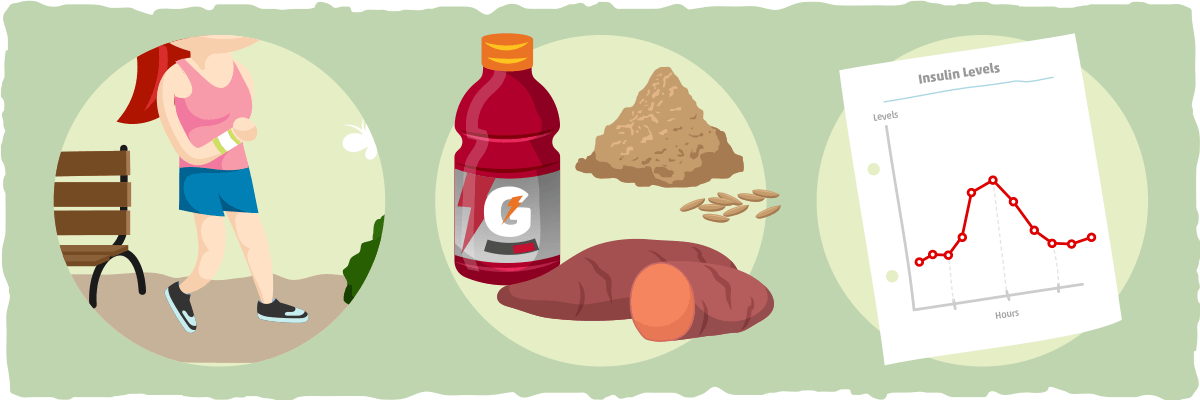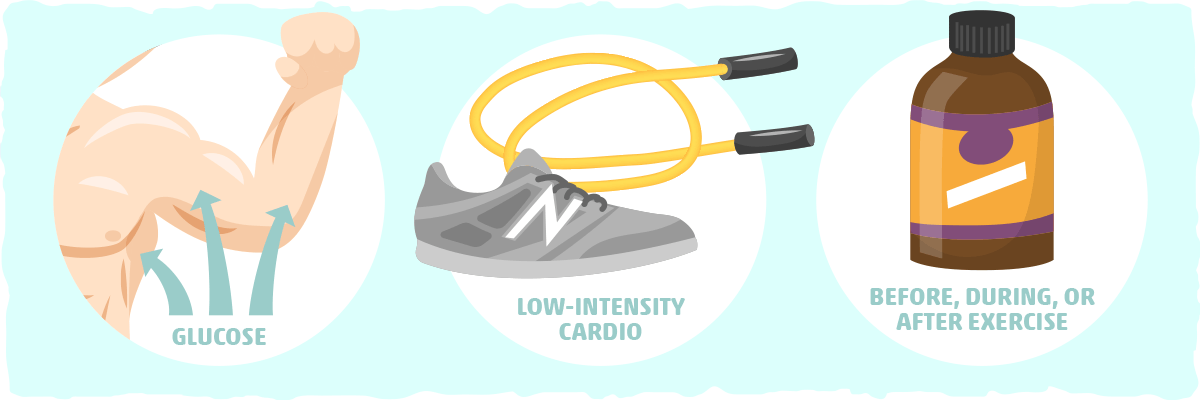The Targeted Ketogenic Diet (TKD), simply put, is a standard keto diet that is supplemented with carbohydrate intake around your workout times. That means any day you exercise, you will typically be consuming pre workout carbs.
The TKD is meant to improve exercise performance for high-intensity workouts or extended bouts of activity. On the other hand, if you are sedentary or only do low-moderate intensity exercise, then the standard ketogenic diet is all you need.
For more about targeted keto, let’s take a closer look at the following topics:
- What is a TKD?
- How does it work?
- What are the benefits of targeted keto?
- What to eat & how many carbs should you eat with this keto approach?
- Targeted carbohydrate intake and ketosis
- Should you implement a TKD or stick with a traditional keto diet?
- How to start a targeted keto diet
- Targeted keto FAQs
- Key takeaways: Keto, exercise, and long-term weight loss results
What is a Targeted Keto Diet?
Targeted Keto is a “compromise” between a Standard Ketogenic Diet and a Cyclical Ketogenic Diet, meaning you increase net carb intake to promote high-intensity exercise performance, but you won’t have to be out of nutritional ketosis for long periods of time.
For most people’s purposes, TKD can help us maintain high-intensity exercise performance and aid recovery. It’s most appropriate for beginner or intermediate strength trainers, high-intensity sporting athletes, or for those who cannot use cyclical keto (due to scheduling conflicts or health reasons).
How Targeted Keto Works: Exercise Physiology 101
By targeting carb intake around high-intensity exercise, you’re providing your muscle cells with the fast-burning fuel essential for max (or near-max) effort activities lasting between 10 seconds and 2 minutes.
Carbohydrates are essential because — after around 10 seconds of near-maximal to all-out effort — the muscles start to rely on glucose for energy by using a metabolic pathway called glycolysis instead of the phosphagen system (which depends on creatine phosphate and ATP, not glucose).
On the other hand, fats and ketones are burned at such a slow rate that they are only used at low and moderate intensities. For most, this occurs during activities that last longer than 2-3 minutes without rest, such as cycling, jogging, hiking, or brisk walking.
Keep in mind, however, that the timing of each metabolic pathway depends on the person. Some people may be able to maintain their performance for high-intensity efforts that last 30 seconds without having to burn carbs, while others may burn out after 10 seconds of all-out effort.
Benefits of a TKD

With the exercise physiology section in mind, it’s easier to understand the potential benefits of targeted keto vs. a very low-carb, high fat diet. Not only will you experience similar benefits as a traditional keto diet, but you’ll be able to take advantage of glucose (from pre workout carb intake) for high-intensity exercise performance.
In fact, many keto dieters who use a targeted approach report strength and endurance improvements during high-intensity activities when nothing else seems to work.
Current research indicates that endurance athletes and moderate-intensity exercisers can benefit from the targeted ketogenic diet when participating in activities that last an hour and a half or longer. Studies show that supplementing with carbohydrate intake before long endurance tasks, like running a half marathon, can improve performance and reduce the perceived exertion of the runners without impairing ketosis.
In other words, using pre-workout carbs can help improve performance and reduce how difficult the activity feels. Although this was only found to occur in studies on endurance runners during a half-marathon, this phenomenon may also explain why many keto dieters report having increased strength and endurance during high-intensity exercise as well.
Another benefit of consuming carbohydrates prior to working out is the effect that it has on insulin levels. Yes, high insulin levels are the exact opposite of what you want on a standard ketogenic diet — but when it’s released at the right times, insulin can have an anabolic effect that prevents muscle breakdown and promotes increases in lean muscle mass.
The Takeaway: To sum up this section simply, if you’re an athlete or if you exercise regularly and your performance has been suffering, then try experimenting with extra carbohydrate intake before your training. By doing this, you’ll provide fast-burning fuel for your muscles, replenish muscle glycogen, decrease how strenuous the exercise feels, boost recovery, and improve overall performance.
What To Eat on The Targeted Ketogenic Diet (TKD)

Most people experimenting with TKD find that 25-50g of carbohydrates taken 30 minutes prior to exercise gives them the best performance. Most suggest eating simple, easily digestible carbs, such as liquids or high glycemic foods that absorb fast into the body — sweet tarts, white bread, candy bars.
However, the best sources of carbs for a successful TKD would be dextrose and glucose. You want to avoid fructose, as it tends to go directly to the liver to replenish liver glycogen (instead of going to the muscle, which is what we want). The highest fructose foods tend to be natural foods like fruit and honey.
On the other hand, some good carb sources for TKD are things like gummy bears, hard candies, Gatorade, and Powerade. People also have shown great results taking in natural maple syrup prior to workouts. However, all of these options still contain a decent amount of fructose.
To get the purest form of glucose, try supplementing with dextrose tablets or glucose gel packets. These will provide you with a pure source of glucose without any fructose, making them the cleanest carb sources for the TKD.
Regardless of what carb source you choose, it should be consumed on its own or with protein (for a muscle building effect). Fat consumption should generally be avoided immediately before and after exercise. Dietary fat tends to slow the digestion of protein and carbohydrate, which is something you don’t want while you are implementing the TKD.
The only fats that won’t impact carb or protein digestion are medium chain triglycerides (MCTs) because they are digested more quickly than any other fat. As a side bonus, they also help increase ketone levels whether you eat carbs or not. This makes MCTs a great addition to your pre or post workout meal if you are looking to increase your ketone levels.
The Takeaway: Eat 25-50 grams of carbs from high-glucose, non-fat foods like gummy bears, hard candies, Gatorade, Powerade, and natural maple syrup. Cleaner forms of glucose like dextrose supplements and glucose gel packs may be even more effective. Consume protein with your carbs to boost muscle growth and/or MCTs to increase ketone levels.
Will The TKD Kick Me Out of Ketosis?

With the influx of carbs that you will be taking in before exercise, your ketones levels will inevitably decrease. By how much will they drop? It depends.
Many will find that they drop out of ketosis for a few hours after their workout, due to the increased insulin levels. The good news is that working out will make various systemic changes that help you get back into ketosis.
For example, working out can help increase insulin sensitivity, which means that less insulin will be needed to handle the 25-50 grams that you eat on the TKD. Cell membrane proteins called glucose transporters will also be more active as a result of the exercise, turning muscles into a glucose magnet that suck up sugar from the blood. The combination of increased insulin sensitivity and glucose transporter activity will ensure that the carbs are used up by muscle, insulin levels drop, and ketone production will be ramped up sooner rather than later.
If you want to boost your ketone levels naturally, you can do some low-intensity cardio to help lower insulin even more and increase the free fatty acids in your blood (more free fatty acids = more ketones). Another strategy that you can use to boost ketone levels is to supplement with MCTs before, during, or after exercise. These fatty acids will be converted into ketones regardless of your insulin and blood sugar levels.
It is important to realize, however, that you may not need to use either one of these ketone boosting strategies. Your ketone levels depend on many factors including your workout intensity, workout duration, stress levels, how keto-adapted you are, and your insulin levels, so you might stay in ketosis after you ingest the pre-workout carbohydrates. On the other hand, you may stop producing ketones completely for a couple of hours.
Does this mean you should rigidly track your ketone levels before, during, and after your workouts on TKD?
Although you can measure your ketones to find out if you are in ketosis or not, this is completely unnecessary. The most important thing is that you stick to your ketogenic diet plan after your workout. If you do so, you will be in ketosis in a couple of hours, and your results will not suffer at all.
The Takeaway: Eating carbs pre-workout will decrease your ketones levels. How much your ketone levels decrease depends on many factors, but — as long as you stick to the ketogenic diet — you will have no problem getting back into ketosis. If you would like to give your ketone levels a boost, then do some low-intensity exercise after your workout and/or supplement with MCTs.
Should I Implement a Targeted Keto Diet?
If you are a beginner or intermediate weight lifter, athlete, and/or training at high intensities regularly, then you might want to try a TKD. This dietary approach may provide you with the performance boost you need but are not getting from following the SKD alone.
Remember, the goal with a targeted keto approach is to get JUST enough carbs to provide glucose for the workout, allowing you to boost performance and build more lean muscle mass while keeping body fat down.
After you are keto-adapted, however, the extra carbs may not be helpful anymore. This represents that your body has now developed the ability to replenish its own glycogen stores and maintain sufficient muscle glycogen levels without the need for additional dietary carbs. Studies show this can happen after around four weeks for athletes on a strict keto diet.
For this reason, you may experience that the TKD doesn’t do anything for you after you are on the keto diet for 1-2 months and you are keto-adapted. If this is the case, then you should stick with the SKD or try the Cyclical Ketogenic Diet (best for high-intensity athletes/exercisers).
How Do I Start a TKD?
Here’s a step-by-step guide on how you can execute the targeted keto diet properly and get the best results:
1. Setting Up Your Keto Macros and Carb Intake
If you’re beginning an SKD and want to perform high-intensity exercise, you may have to consume net carbs before your workout.
The way you calculate your macros will be exactly the same, except you must take into account the extra calories you’ll get from eating carbs – adjust your fats as needed.
More specifically, every gram of carbohydrate equals 4 calories, while every gram of fat is 9 calories. If your goal is weight loss, this means that you should reduce your fat intake by around 11 grams if you consume 25 grams of carbs on workout days.
2. Pre-exercise Timing and Best Carbohydrate Sources
The best time to consume carbs is 30-60 minutes prior to your workout, where you will eat around 25 grams of carbohydrates. High-intensity sessions lasting longer than an hour may require up to 50 grams.
It’s best to ingest quickly absorbing, high GI carbohydrates. Stick to sugar sources that are high in glucose, as fructose can refill liver glycogen and interrupt ketosis post-exercise.
The best carbohydrate sources for the TKD are glucose gels, hard candies, gummy bears, sugary sports drinks (without high fructose corn syrup), natural maple syrup/sugar, and dextrose supplements.
Most fats should be avoided at this time, as they slow the digestion process. If you must have fat before your workout, then have ketogenic MCTs (capric and/or caprylic acid).
3. Optimal Post-exercise Nutrition
Instead of ingesting carbs post-workout, have a high-quality protein shake to boost recovery and lean muscle growth. Having carbs post-workout is entirely unnecessary.
Eating the right amount of fat and protein throughout the day is crucial for maintaining performance, recovering from exercise, and building lean muscle mass.
If you want to build muscle mass and lose fat simultaneously, you may need to follow a high protein ketogenic diet. To learn more about formulating an optimal keto approach for muscle growth, read through our comprehensive keto bodybuilding guide.
Special considerations and tips:
- If you have to ingest more than 50g of carbs around your training, then try to split it up – eat half of those carbs 30 minutes before the workout and half right before you start.
- If you have various training sessions a day, divide your 25-50 grams of carbs between both sessions or adjust your carb dosage depending on the intensity and duration (e.g., 15g for the first session and 25g for the second one).
- Try experimenting with supplements that have been proven to boost performance like creatine, taurine, beta-alanine, L-citrulline, and MCTs. For more information on these supplements and recommended dosages, check out our guide to keto bodybuilding.
- If following the TKD isn’t working for you, consider trying the cyclical ketogenic diet.
FAQs about Targeted Keto and Exercise
What are the 3 keto diets?
There are three main styles of the keto diet:
- Standard Ketogenic Diet (SKD). This is the traditional version of keto that most people follow. It is very low in carbs (typically under 35 g), moderate in protein, and high in fat.
- Cyclical Ketogenic Diet (CKD). A dietary approach that combines carb loading day(s) with the SKD. This may be also be referred to as keto carb cycling or a cyclic ketogenic diet and is typically used by people who are more advanced in terms of high-intensity training.
- Targeted Ketogenic Diet (TKD). A standard keto diet with targeted net carb supplementation prior to high-intensity exercise.
Learn more about these three ketogenic approaches by following this link.
How many carbs are in a targeted keto diet?
In general, targeted keto requires us to supplement a standard keto diet with ~25 g of pre-workout net carbs.
For example, if your carb limit for your traditional keto diet is 35 grams of total carbs and 25 grams of net carbs, then your carb intake will be roughly 60 g total carbs and 50 g net carbs on a high-intensity workout day. To learn more about keto carb limits, follow this link.
Will eating extra carbs impair my health?
Despite the demonization of simple sugars in the keto community, they can have a place in a healthy lifestyle for those who train at high intensities regularly. When consumed as a means to improve exercise performance, they can actually contribute to better health outcomes.
On the other hand, If you are sedentary or doing cardio-type exercises, stick with the standard keto instead. Consuming extra net carbs will not benefit you and may even impair your health & weight loss results.
What is a high-intensity activity?
High-intensity exercises are activities that require continuous near-maximal to maximal effort for roughly 10 seconds – 2 minutes. Examples of this include:
- Lifting weights for >5 rep sets using a weight that is heavy enough to take you to failure (or close to it).
- Sprinting or swimming for longer than 10 seconds (e.g., 100-meter sprint or 50-meter freestyle swim).
- Playing sports with minimal rest breaks and occasional sprinting like soccer, rugby, and lacrosse.
- High-intensity interval training (HIIT).
Though this isn’t a comprehensive list of the activities that carbohydrate restriction will impact, it gives you an idea of the types of exercise that require your body to go into glycolysis and burn glucose for fuel.
Should I take exogenous ketones and MCT oil for exercise performance?
Exogenous ketones and MCT oil will not boost high-intensity exercise performance. However, if you are an ultra-endurance athlete, taking these keto supplements during competition can help preserve muscle glycogen stores for when you need it most (e.g., during the final leg of the race).
On the other hand, those who exercise regularly won’t benefit much from exogenous ketone supplements. In this case, MCT oil (that is composed of 100% caprylic acid and/or capric acid) is the better option.
Though MCT oil won’t provide fuel for high-intensity activities, it can be used as a tool to help boost nutritional ketosis, accelerate the keto-adaptation process, and remedy some keto flu symptoms during your first week of keto.
Key Takeaways: Targeted, Cyclical, and Traditional Keto Diets for Exercise Performance & Weight Loss Results
By restricting carbs, we limit our availability of sugar and muscle glycogen. This is typically not a problem for cardiovascular exercise and low-to-moderate intensity training — but when the activity is more intense, our muscle fibers start looking for sugar to burn rapidly.
As a result, high-intensity exercise performance and recovery may suffer while following a high-fat, low-carb keto diet. There are three potential solutions to this problem:
- Follow a standard ketogenic diet for at least a month to promote keto-adaptation. During this time, your exercise performance and workout recovery will be impaired. However, as your body adapts to carb restriction, you’ll steadily regain the ability to train at a higher level. Adequate protein intake will play a crucial role in this process.
- Try a cyclical ketogenic diet. Those who are more advanced with their training and train at higher volumes may fare better with the CKD. To learn more about combining carb cycling with keto, read our guide to cyclical keto.
- Experiment with targeted keto by adding pre-workout carbohydrates to your routine. Typically, we recommend that exercise beginners (i.e., people who have been training at high-intensities for less than a year) try the TKD. This should only be used if you notice a significant decrease in performance on standard keto.
Regardless of what keto variation you try, make sure you are mindful of how it fits into your keto lifestyle as well. It can be easy to lose track of the bigger picture as we focus on the finer details.
To help you formulate a keto plan that works in the short-term and is sustainable in the long run, read through the following keto resources:
- Complete Guide to Exercise on the Ketogenic Diet — Everything you need to know about keto and exercise.
- How to Maintain Long-Term Keto Weight Loss Results for Life — Learn how to achieve and maintain your results.
- Is the Ketogenic Diet Right for You? — How to know if keto is optimal for you
Sources:
- Effects of a 4-Week Very Low-Carbohydrate Diet on High-Intensity Interval Training Responses — NCBI
- The Effect of a Ketogenic Low-Carbohydrate, High-Fat Diet on Aerobic Capacity and Exercise Performance in Endurance Athletes: A Systematic Review and Meta-Analysis — NCBI
- Effects of 30 days of ketogenic diet on body composition, muscle strength, muscle area, metabolism, and performance in semi-professional soccer players — NCBI
- Complete Guide to Exercise on the Ketogenic Diet — Ruled Me
- CKD vs TKD vs SKD [Types of Keto Diets Explained] — Ruled Me
